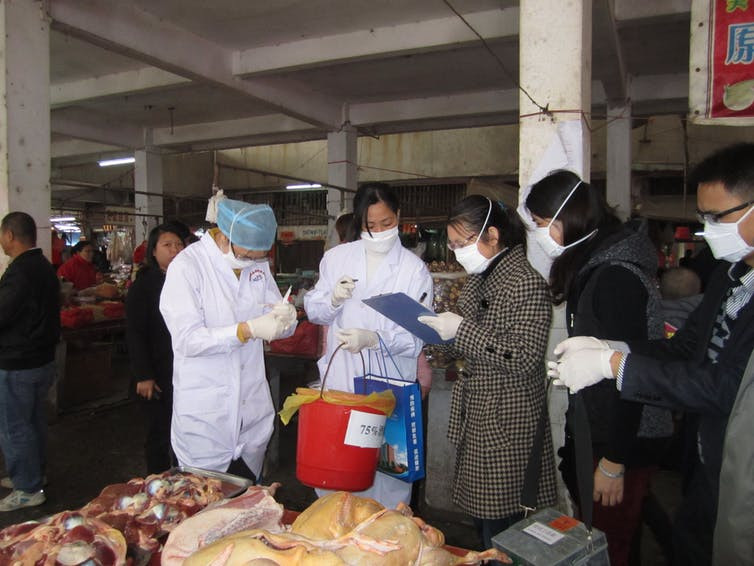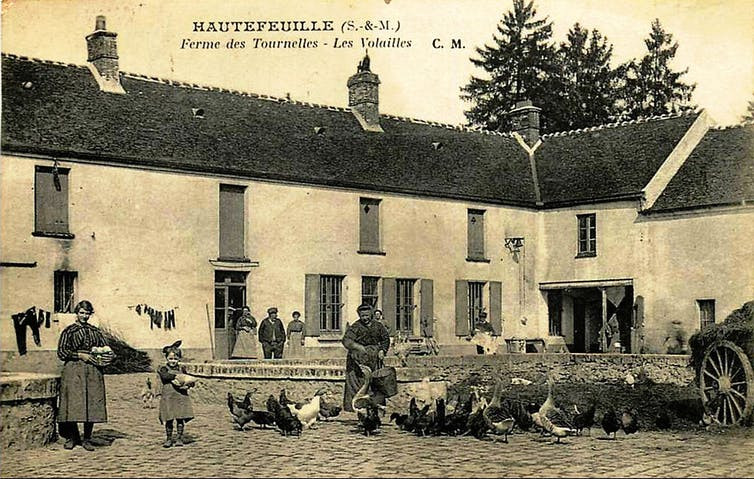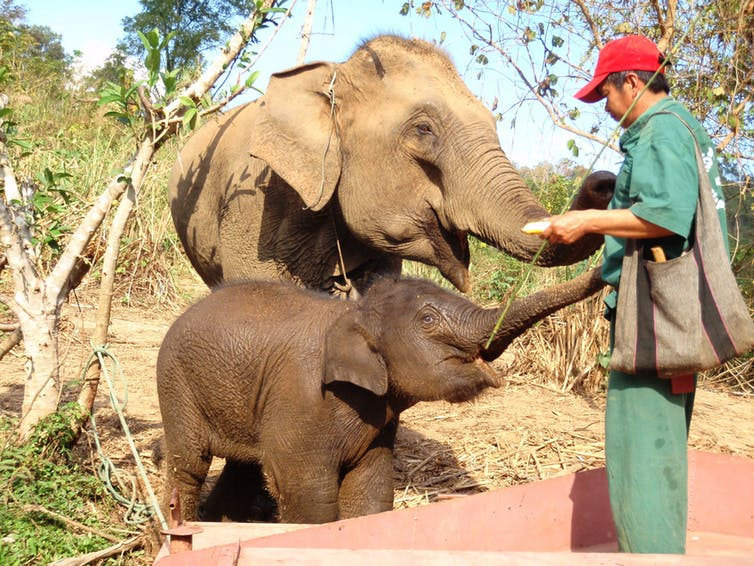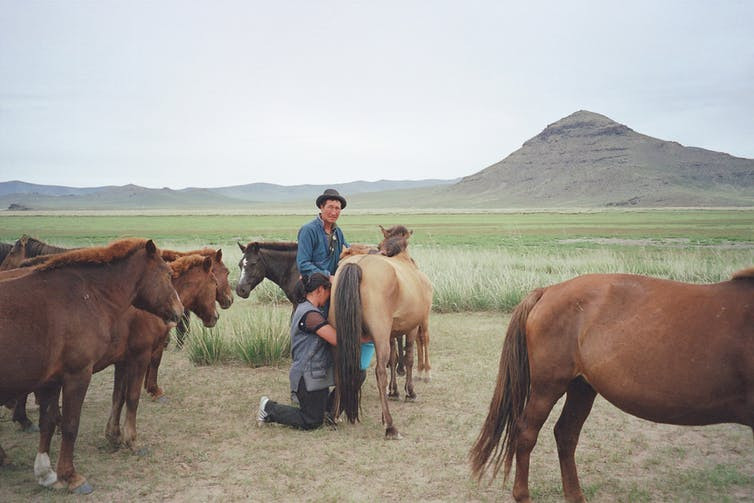In France, following the discovery of 12 outbreaks of the H5N8 virus in domestic poultry and wild birds, the French minister for agriculture raised the flu risk level to “high”, triggering containment measures to protect farms. Several thousand domestic birds have since been slaughtered. To add to the discouragement of farmers in the South West, these measures followed the suspension of a surveillance plan set up last year after similar cases were found.

Foie Gras is a South-Western French delicacy highly sought after during Christmas and New Year. It is usually made from duck liver. Nikodem Nikaji,CC BY
They had hoped to get business back on track in the lead up to Christmas — the region is famous for its foie gras.
H5N8, which arrived in Europe from Asia in early 2015, is not transmissible to humans but it is highly pathogenic in domestic poultry. Instead of attacking the respiratory system, as the flu virus does in humans, it destroys the birds’ digestive system.
It triggers an epizootic — a disease event involving a species of animal in a specific area — rather than an epidemic, a term that applies only to outbreaks in humans.
However, health authorities fear that H5N8 could cross with H5N1, a virus that affects humans. H5N1, identified for the first time in Hong Kong in 1997, infected poultry farms in the East of France between 2005 and 2007.
TVB News on the avian flu break in 1997 in Hong-Kong
It surfaced again in the country’s southwest in December 2015.
H5N1 causes a zoonosis, meaning it can be transmitted between different species after having spread in an animal reservoir displaying few or no symptoms. The 2009 H1N1 flu pandemic resulted in fewer fatalities than had been feared because the virus passed via swine, rendering it less lethal. H5N1, however, can be transmitted directly from birds to humans.
Due to the great differences between these two host species, H5N1 provokes severe inflammatory reactions in humans, killing two-thirds of infected people.
Crossing the species barrier
The flu virus’ ability to mutate and cross the species barrier was discovered in the 1960s. The World Health Organization (WHO) now classifies these viruses according to the proteins found on their surface: hemagglutinin (H) and neuraminidase (N), which determine the way viruses enter and exit targeted cells.
Costly precautionary measures were only imposed on farmers worldwide following the emergence of H5N1 in 1997. Since then, billions of birds have been slaughtered, and around 500 people have died of this virus.

Chinese health authorities carry out an investigation in Dongguan during the 2014 H7N9 flu outbreak. Shuqing Zhao/CDC Global/Flickr,CC BY-SA
How many animals should be slaughtered in order to protect populations against a potential virus pandemic? This cannot be left entirely up to health authorities, who naturally tend to emphasise the risk to humans. When weighed up against a human life, a bird’s life counts for little in their eyes.
French agricultural authorities have been in charge of large-scale poultry slaughter since the 1960s. The upsurge in industrial farming, where animals lacking genetic diversity are kept in close quarters, has exponentially increased the risk of infectious diseases. Thus, when the H5N2 virus, highly pathogenic in birds but not transmissible to humans, was discovered in Pennsylvania in 1983, the US Department of Agriculture ordered the slaughter of 17 million poultry.
Transmission from the wild to the domestic
What do these precautionary measures mean for farmers? Financial compensation for slaughter is never equivalent to the real market value of the destroyed animals, especially when, as is the case this time, the poultry were bred to produce foie gras, a product with significant added value.
The psychological impact of these measures must also be taken into account. Not only can they damage the reputation of a farm, or of an entire sector (the US is as quick to denounce the foie gras industry as a neighbour is to criticise a farmer’s lack of transparency or cleanliness), but they destroy farmers’ emotional investment in the care and conservation of their flock.

A poultry farm in Hautefeuille, centre of France, at the beginning of the 20th century. CM
Poultry require daily care for selection, feeding, and monitoring. France witnessed an outpouring of empathy from farmers during the slaughter of bovines with suspected spongiform encephalopathy (mad cow disease), which spread through Europe in the 2000s. While we are unlikely to see the same for duck farmers who force-feed their animals, it is still fair to say that these farmers are attached to the birds they have domesticated — that is, taken into their homes (domus), according to the root of the word.
Through a project on social representations of pathogens at the frontiers between species, I managed a team of anthropologists who studied how zoonoses are managed outside of France and Europe. The risk of infection from the wild is perceived differently, depending on the kind of attachment people have to their domestic animals.
Zoonoses are the result of pathogens passing from the wild into the domestic sphere. However, the boundary between the two is not fixed and varies in each society based on its relationship to animals.
In Laos, for example, elephant owners and mahouts do not see their animals as being wild, but rather as companions. They take care of them by calling on their “spirits”. Mahouts work seasonally with their elephants to gather wood in forests and parks. In 2012, cases of tuberculosis were discovered in elephants. Tourists, who enjoy a ride on the back of these quintessentially wild animals, may risk infection.

In Laos, mahouts have a special relationship to their elephants. Sophie47,CC BY-NC
The owners of infected elephants do not mention these risks when talking to tourists, not only for fear of losing lucrative business, but also because the tuberculosis bacillus is not one of the “spirits” they invoke when caring for their animals.
Likewise, in Australia, the bat is not seen by Aboriginal people as a wild animal living separately from humans. Rather, bats are totemic. Some groups trace their ancestral roots back to them, while others eat them for medical reasons, which explains their frequent representation in indigenous art.
Yet bats are thought to be a reservoir for several zoonoses, such as Ebola, Hendra, Nipah and SARS, due to the great diversity of bat subspecies and their proximity to caves and trees.
Mongolia is another interesting case, because the bulk of its economy relies on raising livestock: bovines, sheep, camels and horses.

A farmer in Mongolia milks a mare. JeanneMenjoulet&Cie/Flickr,CC BY-SA
The country recently opened up to international flows, exposing it to an increase of zoonotic and epizootic outbreaks, including brucellosis, anthrax, and foot-and-mouth disease. Farmers protect themselves and their animals from these diseases by combining vaccination with traditional shamanic or Buddhist techniques.
In recent years, the Mongolian government has ordered the large-scale slaughter of gazelles living on the Chinese and Russian borders, in order to limit the transmission of pathogens to livestock. But it is now involved in attempts to recognise the value of the knowledge of nomadic shepherds, in partnership with the World Organisation for Animal Health, which would like this knowledge to be registered as world heritage.
The lessons of Laos, Australia and Mongolia could be applied in France and other Western countries. The reluctance of French farmers to apply precautionary measures they have trouble understanding echoes that of police officers who must apply increasingly stringent anti-terrorism measures.
The French state could recognise the value of farmers’ work, not only by promoting the label “South-Western foie gras” but, more importantly, by highlighting the traditional practices farmers use to take care of the animals we eat, and the benefits of their vigilance for public health.
Source : The Conversation




